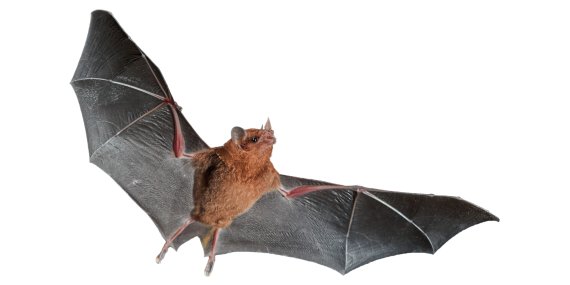Not a human invention
Fans of conspiracy theories, take note: this coronavirus was definitely not made by humans. Research by Kristian Andesen et al. of the Scripps Research Institute gives irrefutable proof of this. The researchers base their conclusion on the analysis of spike proteins, which the virus uses to attach itself to human cells. These protrusions look like a crown from some angles, giving the virus class its name. The spike attaches itself to a protein on the cell wall, fitting so neatly that the researchers say this could only be the result of evolution. What is more, the general molecular structure of the virus is very similar to known, non-pathogenic coronaviruses that are found in bats and pangolins (scaly anteaters). According to the scientists, if someone had wanted to deliberately design a deadly virus, they would have used an existing pathogenic virus. The researchers conclude that we can rule out the possibility the virus was developed by humans.
Bats
This coronavirus very probably came from bats. Its relatives SARS, MERS and Ebola were also transmitted to humans via bats, either directly or indirectly. That is no coincidence, say researchers (Cara Brook et al.) from the University of California, Berkeley. Bats have an advanced immune system that is constantly on high alert. Viruses arm themselves against it by reproducing faster and faster, before the bat’s immune system can strike back. Mammals with less advanced immune systems, such as humans, are defenceless against these viruses.
Coronavirus was definitely not made by humans
Virus survives longest on plastic
Coronaviruses can survive a long time outside human hosts. It all depends on what surface they end up on, according to American research (Neeltje van Doremalen et al.) from the National Institute of Allergy and Infectious Diseases. The scientists tested the stability of the novel coronavirus and the SARS virus in five different conditions: contained in an aerosol (a cloud of droplets) or placed on plastic, cardboard, copper or stainless steel. It turned out that the surroundings made a huge difference. The coronavirus gave up the ghost soonest in an aerosol (air): it did not survive more than a couple of hours. Next were copper (four hours) and cardboard (24 hours). The virus remained stable for longest on stainless steel (48 hours) and plastic (72 hours). The quantity did decline exponentially over time.
No symptoms, but still infectious
You can catch the coronavirus from a carrier who doesn’t have any of the symptoms of the disease. This was shown by Chinese/American research (Zhanwei Du et al.) from the University of Texas. The researchers determined the time between the first signs of the disease — the serial interval — in Chinese patients who had infected one another with the virus. That interval was only four days on average. A much more alarming result was the finding that in 13 per cent of the cases, the second person infected showed symptoms before the person who had given them the virus did. So even if you don’t have symptoms, you may still be carrying and transmitting the virus.
Bood group makes a difference
People with the blood group A are more susceptible to the coronavirus than people with O, according to a Chinese study (Wang Xinghuan et al.) from Wuhan University. The researchers investigated blood samples from 2100 patients in two hospitals in Wuhan and Shenzhen. Of the patients who died from the virus, 41 per cent had blood group A and 25 per cent blood group O. The two groups are found in roughly equal proportions in the local Chinese population. The same pattern was seen in the SARS outbreak in 2003. It is not clear why the virus has a bigger effect in blood group A.

